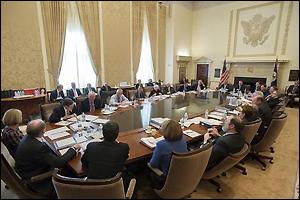Courtesy of Pam Martens
Earlier this week, James Freeman, the Assistant Editor of The Wall Street Journal’s editorial page, wrote an opinion piece headlined as “We’ll Never Know How Bad the Federal Reserve Is.” Freeman is also a Fox News contributor so one might be prone to suspect there is that typical right-wing bias to bash the Fed.
Freeman, however, has a legitimate beef. His new book, “Borrowed Time: Two Centuries of Booms, Busts and Bailouts at Citi,” with co-author Vern McKinley was published this week and Freeman laments in the article about how the Fed “hides and then destroys documents.” If you’re a journalist attempting to compile a truthful and accurate account about a financial institution or a financial era and a key institution holding those documents refuses to release them, then the American people have lost the ability to exercise oversight of their government.
At Wall Street On Parade, we know exactly how bad the Federal Reserve is. Before 1999, the Federal Reserve typified the assessment of American democracy – the worst form of government, except for all the others. In 1999, Alan Greenspan, then Chair of the Federal Reserve, got what he and Wall Street had been pushing for years to achieve: the repeal of the Glass-Steagall Act which had protected the U.S. financial system for 66 years by barring banks holding Federally-insured deposits from combining with investment banks engaged in underwriting and trading in securities. In 2010, Wall Street got the balance of its wish list: the Dodd Frank financial reform legislation made the Federal Reserve the primary regulator of the now behemoth Wall Street bank holding companies, despite the fact that it had been asleep at the switch as the worst financial crash since the Great Depression was incubating on Wall Street.
Most people, even those paying close attention to the Fed’s bailouts of Wall Street, think that the big banks were fine until the 2008 crash. But the public will never really know because Wall Street got another secret bailout from the Fed after the terror attacks of September 11, 2001. (Read our previous report here.) There is the forgotten history that Wall Street was already heading for a crash before the planes struck on 9/11. In fact, on the day before 9/11, the Nasdaq stock market had lost 66 percent of its market value over the preceding months and had evaporated $4 trillion in wealth. The economy had contracted for two consecutive quarters and was facing another quarter of negative growth.
We may never really know the full story of the Fed’s pump priming of Wall Street after 9/11 but we do know this: The Fed’s balance sheet grew from $609.9 billion at the end of 2000 to $654.9 billion at the end of 2001 to $730.9 billion at the end of 2002 and $771.5 billion as of December 31, 2003. To some folks, that looks a lot like an earlier version of quantitative easing.
…




